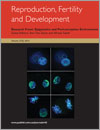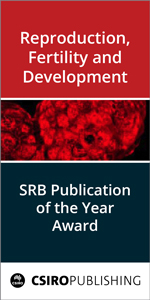
Reproduction, Fertility and Development
Volume 27 Number 5 2015
RESEARCH FRONT: Epigenetics and Periconception Environment
RD14167Epigenetic processes in the male germline
Epigenetic modification of the mammalian genome is indispensable for successful development. Many of these modifications, such as DNA methylation, are established and removed during gametogenesis, following fertilisation and during the early stages of embryogenesis. These epigenetic modifications occur at different times during meiosis, depending on whether they occur during spermatogenesis or oogenesis. Similarly, post-fertilisation modification dynamics occur differently depending on the parental origin of the genomic material. This review will focus on these processes in the male germline.
RD14333DNA methylation reprogramming during oogenesis and interference by reproductive technologies: Studies in mouse and bovine models
It is estimated that, globally, 56% of couples seek medical care for infertility. Assisted reproductive technologies (ART), such as ovarian stimulation and in vitro embryo production, are used to overcome infertility. Despite increasing use, ART is associated with low pregnancy rates, premature birth and low birth weight. Here we discuss studies investigating the mechanisms by which ART affects oocytes and embryos, paying particular attention to DNA methylation.
RD14136Determinants of valid measurements of global changes in 5ʹ-methylcytosine and 5ʹ-hydroxymethylcytosine by immunolocalisation in the early embryo
After fertilisation, the embryonic genome must undergo heavy DNA methylation and hydroxymethylation changes that are critical for its development to term. Herein, we focus on the main method used to study these epigenetic modifications in early embryos. Our work emphasises the pitfalls of this method and shows that contradictions observed in the literature can be explained to a considerable extent by its incorrect use.
RD14216Why we should not select the faster embryo: lessons from mice and cattle
Many studies have shown that in vitro culture can negatively impact preimplantation development, which necessitates some selection criteria to identify the best-suited embryos for transfer. With emerging data in bovine and mouse supporting increased developmental competency in embryos with moderate rates of development, it is time to question whether the fastest developing embryos are the best embryos for transfer in the human clinic. In this review we explore evidence surrounding the question of developmental timing as it relates to bovine embryo quality, mouse embryo quality and genomic imprint maintenance, and embryo sex.
RD14246Phenotype switching through epigenetic conversion
Increasing knowledge of the mechanisms controlling epigenetic regulation of cell fate has provided new understanding of cell commitment and specification. Epigenetic events, such as chromatin remodelling and DNA methylation, have been shown to impose flexible but precise control over the expression of regulatory genes, allowing a dynamic interfacing between genotype and phenotype and modulating cell differentiation plasticity and commitment. In this paper we discuss the use of epigenetic modifiers to obtain high plasticity cells that can then be redirected to acquire a different phenotype. This approach is termed ‘direct epigenetic conversion’. It is a simple, direct and safe way to obtain cells for cell therapy and regenerative medicine.
RD13400Sperm survival kinetics in different types of bull semen: progressive motility, plasma membrane integrity, acrosomal status and reactive oxygen species generation
Sperm survival is important for the fertilisation of oocytes. The kinetics of progressive sperm motility, acrosomes, plasma membrane and generation of reactive oxygen species were determined in vitro over 24 h. Bull sperm longevity was poor in frozen–thawed semen. Different types of spermatozoa followed different death pathways. All types of spermatozoa generated superoxide anions during incubation, which adversely affected their plasma membranes.
RD13412Elective single versus double embryo transfer: live birth outcome and patient acceptance in a prospective randomised trial
The aim of the study was to determine which strategy (i.e. single (eSET) versus double (eDET) embryo transfer) has a better trade-off in live birth delivery considering patient acceptance. The live birth delivery rate was significantly higher after eDET versus eSET (65% vs 42%, respectively), but no multiple births were observed after eSET compared with 35% after eDET. Nearly half the patients refused eSET even after having been well informed of its benefits.
RD13336Oocyte expression, secretion and somatic cell interaction of mouse bone morphogenetic protein 15 during the peri-ovulatory period
New work investigating how mammalian eggs achieve ovulation has found that the key fertility protein bone morphogenetic protein 15 (BMP15) is produced by the egg in more than one protein form just before ovulation. Whereas most previous studies focused on the mature region of BMP15, the present study shows that the proregion form is also increasingly produced just before ovulation and binds to surrounding cumulus and granulosa cells. This finding furthers our understanding of the complexity of BMP15 signalling and provides promising new routes of improving fertility treatments.
RD13419Variation of spermatogenic and Sertoli cell number detected by fine needle aspiration cytology (FNAC) in Iberian red deer during and out of the breeding season
Few studies have dealt with spermatogenesis in red deer, which represent a good model in which to investigate testicular function owing to their reproductive seasonality. Herein, we found that both spermatogenesis and Sertoli cell number decreased significantly out of the breeding season in Iberian red deer. Our results provide new insights into the dynamics of spermatogenesis and Sertoli cell populations, and challenge current dogma that Sertoli cell number is fixed in adulthood.
RD13388Developmental programming of bone deficits in growth-restricted offspring
Offspring born with low birth weight are predisposed to a number of adult diseases, including osteoporosis. Herein, we report that such rat offspring develop reduced bone mineral content and strength at various ages. Importantly these deficits affected males more severely than females and became worse with aging. Interventions to improve bone quality in adult life for individuals born small may reduce the incidence of osteoporosis in the future.
RD13381Effect of pregnancy on endometrial expression of luteolytic pathway components in the mare
Preventing pulsatile endometrial PGF2α release is critical to pregnancy recognition in mares, and downregulation of PTGS2 and OXTR underlies initial avoidance of luteolysis. By Day 21 of pregnancy, however, expression of both PTGS2 and OXTR recovers to levels consistent with luteolysis. Continued luteal maintenance may instead involve uncoupling of PGF2α generating feedback loops by inhibition of PGF2α receptor (PTGFR) expression.
RD14009Effect of different freezing velocities on the quality and fertilising ability of cryopreserved rabbit spermatozoa
The freezing step of the protocol for rabbit sperm cryopreservation negatively influences the performance of the spermatozoa. In this study we show the important role that the freezing rate plays in the quality and fertilising ability of the spermatozoa, with medium freezing rates (–40°C min–1) more suitable for freezing rabbit spermatozoa. These results could help to develop reliable protocols for rabbit sperm cryopreservation.
RD13377Ram spermatozoa migrating through artificial mucus in vitro have reduced mitochondrial membrane potential but retain their viability
The ram sperm population that migrates through a column of cervical mucus surrogates in a penetration test was evaluated. These spermatozoa exhibit an adequate motility to cross the mucus barrier and we think that these cells can give information about the transport through the female genital tract. The viability of migrating spermatozoa was not changed but the mitochondrial status was affected after migration.



